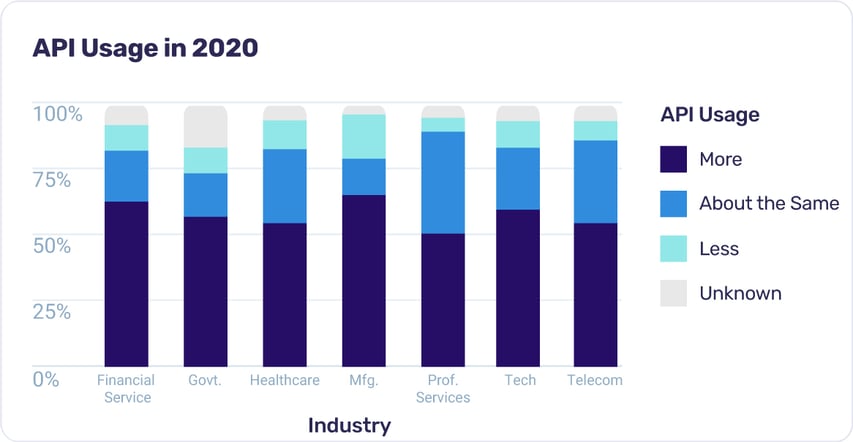The first mention of API (Application Programming Interface) as a concept can be traced back to a book written by British computer scientists in the 1950’s. However, only in the past decade have APIs become a pervasive and indispensable technology juggernaut. An overwhelming majority of organizations use APIs, and its application is only bound to increase in the years to come.

Source: DevOps Digest
APIs do not serve merely as technical channels to share information. Organizations can leverage APIs to connect with much-needed data and services to accelerate innovation, open up new avenues of business for their products and services, and forge new partnerships with other businesses. The rapid proliferation and adoption of APIs has led to the blossoming of the API economy.
How did the API economy come into existence?
APIs are the adhesive that cohesively bring together different software applications. A simple, everyday example is the use of the Google Maps API by a number of apps commonly found on your smartphone, like ride-hailing app, food delivery app, etc. APIs have fueled the paradigm shift from siloed, on-premise software to the cloud and microservices based applications.
This novel approach to building software applications has given organizations the required agility to build, maintain, upgrade, and scale products and services, faster and easier. The abundance of APIs and its continued patronage has led to the establishment of the API economy, which powers the digital ecosystem.
Essentially, the API economy represents the various business models and methodologies that are centred around the use of APIs in today’s digital world. It is indicative of how extensively organizations use APIs to expose their digital offerings and assets and increase profitability. Organizations can also reposition their own services and data as a platform. This opens up a host of collaborative opportunities across a wide range of industries, which were never considered before, and helps build new capacities and experiences.
API Economy = Digital Transformation = Business Imperative
The potential of an organization to bundle its core services, accumulated expertise, and inherent assets into modular blocks of frequently leverageable software is what fuels digital transformation. A majority of organizations around the world have tonnes of precious data and functionalities present in their systems.
However, value from such data and functionalities cannot be exploited, if operated in silos. These silos have to be broken down and the data and functionalities must be made interoperable and reusable in different situations. They can also be integrated with partner and third party assets.
It is basically a large, inclusive digital ecosystem at play. For example, retail banks want their core services to seamlessly blend with e-commerce or retailers apps, the same way such apps wish their customers to have carte blanche, in-app access to a slew of payment options.
APIs are at the center of bringing together such diverse synergies. By extension, the API economy is the driving force behind how organizations leverage APIs to enhance efficiency and profitability through the strengthening of resources, creating new customer demographics, and building new business avenues.
So, how instrumental APIs have become in today’s business landscape? Take a look at the following chart:
.jpg?width=721&name=API-Economy-Blog-2-image-2%20(2).jpg) Source: Apigee API report 2021
Source: Apigee API report 2021
Key Perks of the API Economy
The primary benefit of the API economy is the easy access to and prolific use of APIs. Other benefits include:
- Faster product development and launch: Developers can pick and choose from a wide range of standardized APIs to build and launch new digital products, without breaking a sweat or the bank. For example, a food delivery app can bring together a mapping API, billing API, and chat API, each of them from different service providers, with their own UI/UX built on top of them.
- Enhanced value addition: APIs can be used to deliver much more powerful customer experiences, build a robust partner network, integrate internal applications, create additional revenue streams, and even completely transform a business. Let's take the example of Pitney Bowes. After centuries of being known as a logistics company, they have now transformed themselves into a digital shipping and ecommerce solutions provider. Their digital transformation was achieved by offering their core offerings as APIs.
- Level playing field: The API economy has democratized the business world by enabling different types of organizations (including non-IT companies), irrespective of size, to collaborate and build powerful, innovative digital products and services. A good example is the IBM Watson API. Before the API boom, IBM Watson was limited to only software and technology applications. However, by leveraging the power of APIs, new services have been developed around IBM Watson and applied differently in the areas of travel, shopping, healthcare, and so on.
Not All Roads Lead to Rome
APIs have clearly become a must-have cog in the digital transformation wheel that enterprises wish to move. With so many enterprises, thought leaders, and IT experts extolling the many virtues of APIs, you may not want to be left behind or considered as obsolete.
The knee jerk reaction would be to hasten the API adoption process, without giving much thought to charting out the right API strategy. The outcome? Enterprises find themselves putting out many operational and functional fires in their IT systems, instead of leveraging the benefits that APIs offer and moving forward.
There are a number of reasons why enterprises fail in gaining optimal value out of their API programs; for example, restricting API programs to IT-only ownership and non-alignment with overall business goals. Another good example is sometimes enterprises focus on only certain areas, such as data or cloud migration. The following image lists the common API challenges being faced by enterprises today.
However, the common conundrum that organizations seem to ask themselves is ‘how do we even get started with these APIs?’
Finding Your Way Out of the Maze
The very flexibility that APIs offer, in terms of its potential application in almost every area of business, is what serves as a predicament as well. Organizations are overwhelmed by the sheer range of APIs.
Deciding which APIs to build requires a two-pronged approach - one, identifying the right API that can facilitate key customer-facing applications and two, identifying the ones that can construct the right technical foundation. In the same vein, organizations will then have to select the right pecking order for the APIs, based on their alignment with the overall business strategy, impact on modernization initiatives, and their ability to implement them.
From data access and integration, cloud migration, digital modernization, to selecting the right dev tools and team structure for API implementation, and so on, the process to establishing a successful API program is exhaustive, yet highly rewarding, all at the same time.
You can try striking out on your own or leverage the business expertise and technical acumen of a strong API Management Services partner.
Still on the fence?
From developing APIs, setting up the right API management platform, migrating data, to building API dev portals and successfully monetizing your APIs, the API wishlist is both long and fascinating. Making the right choices is no mean feat. As an API Management Services provider, Srijan can help you correctly navigate through the available API options and home in on the right choices that are a great fit for your business.
We strongly believe in being there for our clients at any given point in the API journey. Our consultative business approach, coupled with our in-depth technical know-how, seeks to take you along the API journey, one step at a time.
For a thorough, first-step analysis of your existing API system or just to explore the possibility of setting up an API initiative, get in touch with us right away. The API economy is definitely the kind of technology movement you want to be part of.
Our Services
Customer Experience Management
- Content Management
- Marketing Automation
- Mobile Application Development
- Drupal Support and Maintanence
Enterprise Modernization, Platforms & Cloud
- Modernization Strategy
- API Management & Developer Portals
- Hybrid Cloud & Cloud Native Platforms
- Site Reliability Engineering




